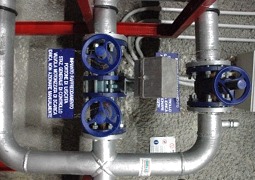|
halon, halon fire extinguisher, halon fire extinguishers, halon 1301, halon 1211, halon recycling, 1031 halon |
|
|

At Gielle Srl we make use of the Fike Intella-Scan Fire Detection Control Panel to control the release of agent. The Intella-Scan II control system uses both intelligent addressable analog sensors and centralized decision making to virtually eliminate false alarms and unwanted agent releases. The sensors report environmental conditions on a real-time basis to the control unit where the microcontroller makes the ultimate alarm decision. And the control panel is modular to allow you to add on to the system as your requirements change over time. Halon Fire Suppression Systems :Leading provider of Halon 1301, 1211 and FM-200 fire suppression systems. Following in the footsteps of the Montreal Protocol the Kyoto Protocol was agreed on the 10 December 1997 and committed the parties to specific reductions in the release of Global Warming Gases. The most significant for the fire protection industry being Carbon Dioxide and hydrofluorocarbons (HFCs). | |
 .jpg)
|
We buy Halon 1301 and FM 200 In bulk by the tank, need tank specs, agent weight, tank weight, tare weight, pressure on gauge reading, make of tank, date of mfgr, etc. What are CFC (Chlorofluorocarbon) They are ozone depleting substances used in fire extinguishant systems, refrigeration and air conditioning equipment including chlorofluorocarbons and hydrochlorofluorocarbons, collectively referred to as CFCs. This group of chemicals has been demonstrated to be harmful to the environment, specifically the stratospheric ozone layer. Fire Suppression Ltd FM-200, FE-241, Halon 1301 and Aero-K Aerosol fire suppression systems for marine vessels, industrial and computer room applications. Why does Halon need replacing As a CFC based gas, Halon 1301 and 1211 are ozone depleting agents. Their release to atmosphere during manufacture, decanting to application cylinders and use or misuse in service has contributed to the depletion of the ozone layer. They also have a long atmospheric life. We supply, design, and ship high performance and high quality Find Deals on halon and other Sports and Outdoors at DealTime Find, compare and buy Halon and other sports and outdoors products Material Safety Data Sheets
Halon 1211 |
Fire Links www.nfpa.org - National Fire Prevention Association (NFPA) www.nafed.org - National Association of Fire Equipment Distributors (NAFED) www.arffwg.org - Aircraft Rescue & Fire Fighting Group ARFF) www.fssa.net - Fire Suppression Systems Association (FSSA) www.harc.org - Halon Alternatives Research Corporation (HARC) www.nist.gov - National Institute of Standards & Technology (NIST) www.esd.worldbank.org/mp - Montreal Protocal Fire needs three elements to prosper: fuel, oxygen and heat. The most common extinguishing agents like water, carbon dioxide, dry chemical and foams attack the fire physically to deprive the fire of one or more of the three critical elements needed for propagation. Halon differs in the way it puts out the fire. It offers some of water's cooling effect and some of carbon dioxide's smothering action, but its essential extinguishing technique lies in its capacity to chemically react with the fire's components. It actually interrupts the chain reaction of fire. Water is very effective on class A fires (common combustibles like wood and paper). Halon is effective on common combustibles (although not as effective as water), but Halon is also effective on class B (flammable liquids), and it does not conduct electricity back to the extinguisher operator (class C). Halon is similar to CO2 in that it is suitable for use in cold weather and leaves no residue. Unlike CO2, however, Halon does not displace the air out of the area where it is dispensed. Even for the toughest fires, less than an 8% concentration of Halon by volume is required, leaving plenty of air to use in the evacuation process. Also, unlike CO2, there is no danger of "cold shocking" avionics or other sensitive electrical equipment. Dry chemical fire extinguishers are effective on A, B and C class fires. However, they are highly corrosive, and create billowing clouds of choking dust; dry chemical extinguishers should not be used in an aviation environment. Foam extinguishers are effective on class A and B fires, and are particularly useful for preventing ignition of flammable liquid spills. However, foams are inferior to Halon in that they do require cleanup and in that they are not for use on electrical fires. Halon 1211 is a liquefied gas which, when discharged, leaves the nozzle in a stream that is about 85% liquid and 15% gas. This gives the agent a range of 9 to 15 feet and offers significant advantages in fighting fires in large aircraft cabins. Mixtures of Halon 1211 and Halon 1301 have discharge characteristics dependent on the component weight ratio. Product range:
| |
|
|
|
© 2006 - all rights reserved - created by www.omnilink.it |

.jpg)